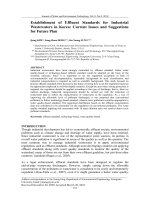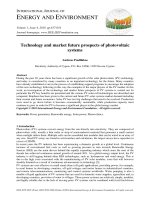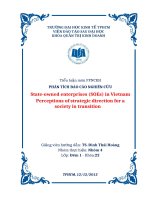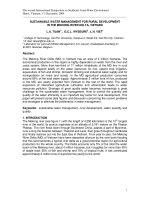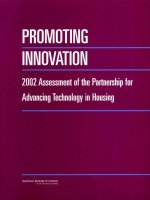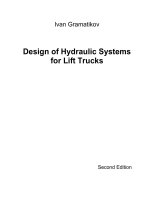- Trang chủ >>
- Khoa Học Tự Nhiên >>
- Vật lý
Diffusion of photovoltaic systems for rural electrification in Thailand
Bạn đang xem bản rút gọn của tài liệu. Xem và tải ngay bản đầy đủ của tài liệu tại đây (99.79 KB, 10 trang )
I
NTERNATIONAL
J
OURNAL OF
E
NERGY AND
E
NVIRONMENT
Volume 4, Issue 1, 2013 pp.49-58
Journal homepage: www.IJEE.IEEFoundation.org
ISSN 2076-2895 (Print), ISSN 2076-2909 (Online) ©2013 International Energy & Environment Foundation. All rights reserved.
Diffusion of photovoltaic systems for rural electrification in
Thailand
Pranpreya Sriwannawit, Staffan Laestadius
Department of Industrial Economics and Management, Royal Institute of Technology (KTH),
Lindstedtsvägen 30, Stockholm 10044, Sweden.
Abstract
This paper studies a pilot project in which photovoltaic systems were installed in thirty-six places in the
remote areas of Thailand with no access to electricity. One sub-project out of thirty-six was chosen for
in-depth investigation. We discuss the appropriateness of solar energy for Thailand context. The
diffusion process of PV systems is analyzed on four elements: innovation, communication channel, time
and social system. This project is an extreme case as the PV systems and services were provided for free
of charge. Even so, there are still some challenges to get acceptance for this sustainable form of energy.
Copyright © 2013 International Energy and Environment Foundation - All rights reserved.
Keywords: Diffusion of innovation; Innovation; Photovoltaic; Rural; Thailand.
1. Introduction
Climate change conditions the transformation process also for developing countries even though they
have low historical as well as actual emissions of greenhouse gases. Although having a strong moral
position in international negotiations, late coming countries face that the window of opportunity is
closing as regards entering upon the classic carbon based path of development and growth. On the other
hand, never having been totally locked in on that carbon path may create opportunities for the
latecomers. Leapfrogging directly to sustainable technologies could thus be a potentially successful
strategy irrespective of the successes in the UNFCCC rounds.
However, transfer or diffusion of new technologies – be they sustainable or not - always take time (we
will return to that below). Not the least is that the case in developing countries when costs and alternative
use of funds can make acquisition prohibitive for poor people in the countryside. Cultural distances
between providers and users as regards what problems the technology is assumed to solve may also
contribute to the stickiness in the diffusion process.
To facilitate the introduction of sustainable energy technologies in backward areas, it is thus important to
learn about absorption problems, parts of which may be assumed to be related to the technology itself,
parts of which may be assumed to be of communicative character.
The objective of this study is to analyze the diffusion of photovoltaic (PV) technology to rural areas in
Thailand and also aims to contribute to the learning on how to manage the leapfrogging policy towards
sustainable energy solutions in developing countries. The paper analyzes a small-scale PV system project
in remote areas of Thailand where the inhabitants did not have access to electricity. We chose an extreme
case in which PV systems were provided for free of charge. Thus, the concern on price which is one
main bottleneck criteria for using PV system [1] is eliminated. By removing this factor, it should be
International Journal of Energy and Environment (IJEE), Volume 4, Issue 1, 2013, pp.49-58
ISSN 2076-2895 (Print), ISSN 2076-2909 (Online) ©2013 International Energy & Environment Foundation. All rights reserved.
50
assumed that the project could be run without any difficulties. This is proved to be incorrect in this study.
The article is organized as follows. Section two provides a brief summary of the research methodology.
Section three introduces the theoretical framework which we use diffusion of innovation, institutional
theory, absorptive capacity and cognitive distance. Section four contains a discussion on sustainable
energy technologies particularly PV in Thailand context. Then we provide descriptive explanation about
the project as a background for the next two sections. In section six, the diffusion process is analyzed.
We combine all the challenges that we identify in section seven. Finally, the paper ends with conclusion
of our research.
2. Methodology
This research is a single case study. A single case can be used to test, confirm, challenge or extend
theories [2]. The analysis may reveal the existence of a phenomenon which may be used to falsify a
conjecture [3]. The case study can thus provide insights on probable and maybe contextual mechanisms
which – together with knowledge we already have – may provide a reasonable solid ground for policy or
management activities. This is the role of the present single case study. This study is basically a
qualitative work [cf. 4]. Neither the selection of interviewees nor the collection of data is performed to
get representative results. Although the study uses numbers on the scale of 1-10 to capture the
interviewees’ perception on specific points, they are not used for statistical purpose. The study may
reveal extreme opinions which we analyze qualitatively.
The study is focused on a pilot project installing PV systems in 36 rural villages in northern Thailand.
This overall project is considered to be the case. One specific project in Banhuaygiangnoi village is
analysed and defined as a sub-case to provide in-depth illustration. The selection of sub-case is based on
convenience. Due to limited resources and time, the sub-case is chosen because it is more accessible than
other places. Some places can be accessed only on foot after a few hours hike while this place can be
accessed by a four-wheel drive car on a very bad conditioned road.
Data are collected through semi-standardized interviews and document analysis. Purposive sampling of
respondents is chosen for the interviews with an intention to capture broader group of respondents.The
interviewees are officers from eight governmental agencies, field teachers who work under Office of the
Non-formal and Informal Education and local people from Banhuaygiangnoi village. The total number of
the interviewees is 26. Interview guides are developed in advance in three main formats according to the
informants. One format of the interview guide is for officers from eight governmental agencies who are
the subjects of the overall case. The second format aims at field teachers who are the subjects of the sub-
case. The last one is for the local people from Banhuaygiangnoi village who are also the subjects of the
sub-case.
In addition to interview data, we use information from documents. In this paper, documents refer only to
written sources which can be official as well as unofficial documents, internal reports or other written
papers [cf. 5].
3. Theoretical framework
This is basically a study on technology diffusion. It can also be argued that this is a study of innovation
as those who adopt technologies developed by others have to innovate to make the innovation fit with
their systems and purposes. For developing countries, this often implies the absorption of innovation that
exists somewhere else in the world and becomes adapted to local needs [6].
Rogers gave a concise definition of diffusion of innovations in the following sentence: “Diffusion is the
process by which an innovation is communicated through certain channels over time among the members
of a social system.” [7: p. 5]. There are, according to him, four main elements in the process of
innovation diffusion namely (a) innovation; (b) communication channel; (c) time; (d) social system [7].
As mentioned in the introduction to this section, the
innovation element in the diffusion process may be
underestimated by analysts. There may be many reasons for bad fitness between the new technology and
the system it is supposed to penetrate. This was, for example, the case with hybrid corn analysed by
Griliches [8]. For many emerging technologies, the reason for slow adoption is simple: they are still not
good enough for demanding potential users, more innovation is needed by the technology providers
rather than more communication.
The communication channel is important in the Rogers’ approach. Mass media (e.g. television or
newspapers) are usually the fastest and most efficient means to inform a wide audience on an innovation.
International Journal of Energy and Environment (IJEE), Volume 4, Issue 1, 2013, pp.49-58
ISSN 2076-2895 (Print), ISSN 2076-2909 (Online) ©2013 International Energy & Environment Foundation. All rights reserved.
51
In contrast, it is more effective to persuade someone through an interpersonal channel especially if it
happens between those with similar background. Diffusion is a social process.
Time is a part of the process and can be further explained into three sub-processes. The first part is an
innovation-decision process which is the stage that one passes the first knowledge of an innovation to
either adoption or rejection. The second one is the relative earliness or lateness that an innovation is
adopted by other individuals. The last stage is the rate of adoption which is measured by the numbers of
people that adopt an innovation in the certain time frame.
The last element in the process is the social system. It is a set of connected units that are bound to one
another to achieve a common goal. The members may range from an individual to an organization. The
system is bound by the fact that members cooperate to reach a mutual goal. Within the social system,
individuals have different roles. Opinion leaders and change agents are one of the important actors for
diffusion process. Opinion leader is individual who can influence others in a desired way. Change agent
is individual who influences other people’s decision making to go towards change agent’s desired way.
Opinion leader usually comes from that community while change agent is the external entity who often
uses opinion leader to influence other people in the community [7].
Rogers' strong focus on communication, the time element and the social system has made him attractive
among marketing researchers [cf. 9]. These approaches are also relevant in our study. In addition, the
cognitive aspects of the diffusion process should be considered.
External sources of knowledge are crucial for the innovation diffusion process. Thus the ability to
employ external knowledge is a very important component. This ability, in turn, is based primarily on
prior knowledge or absorptive capacity. The concept of absorptive capacity was first introduced by
Cohen and Levinthal and defined as follows: “prior related knowledge confers an ability to recognize the
value of new information, assimilate it, and apply it” [10: p. 128]. This implies that all diffusion process
requires certain preparedness and is in principle relevant also for individual users as well as organizations
and firms. The relation of absorptive capacity to innovation diffusion argument discussed above is
obvious: one often has to master the imported innovation/technology to make it fit.
Nooteboom analyzed the impact of cognitive distance between technology providers and users in the
diffusion process. His argument is, in short, that there is an optimum span of cognitive distance favorable
for diffusion: if the span is too large the actors do not understand each other and if it is too small there
are not enough incentives for mutual learning [11, 12].
Our case takes place in a certain institutional context and its outcome may obviously depend not only on
the technologies and its users but also on those institutions involved. Our study will thus be framed
within institutional theory conventionally used by innovation analysts.
Following North we may make a distinction between organization and institution. The following is his
definition of institution: “Institutions are the rules of the game in a society or, more formally, are the
humanly devised constraints that shape human interaction. … Institutions are a creation of human beings.
They evolve and are altered by human beings; hence our theory must begin with the individual.” [13: p.
3-5]. Institutions possess three basic functions. The first function is to reduce uncertainty and provide
information. The second one is to manage conflicts and control cooperation. The last function is to
provide incentives [14]. There are many ways to classify different types of institutions. The relevant
categorization of institutions suitable for this paper is the distinguishing between formal and informal
institutions. The examples of formal institutions are written laws and governmental regulations while
examples of informal institutions are common laws and working norms. The impacts of these institutions
are different in each country. Informal ones are less visible and need to be observed through daily
behaviour [14].
As for the definition of organization, North defined it in the following sentences: “If institutions are the
rules of the game, organizations and their entrepreneurs are the players. Organizations are made up of
groups of individuals bound together by some common purpose to achieve certain objectives.” [15: p.
361]. Organizations include various bodies such as firm, school, regulator [15]. However individuals in
organizations do not necessarily have common goals. There are also internal processes within
organizations which should be reminded when analyzing them [16].
When discussing institution and organization, it is also important to consider linkages which connect
various components. The relevant type of linkage for this paper is interaction linkage between different
actors [17]. We separate it to formal and informal linkages. By saying formal, we mean that it is an
established function such as official command and while saying informal, we mean that it is an unofficial
link between actors such as personal relationship.
International Journal of Energy and Environment (IJEE), Volume 4, Issue 1, 2013, pp.49-58
ISSN 2076-2895 (Print), ISSN 2076-2909 (Online) ©2013 International Energy & Environment Foundation. All rights reserved.
52
4. Sustainable energy and photovoltaic system for Thailand context
Renewable energy has undoubtedly high potential to meet with rising energy demand in the near future.
There are various types of renewable energies. It is necessary to properly appropriate the energy choices.
According to the World Energy Council (WEC), the ranking of renewable energy alternatives should be
considered by using 3A’s principle:
i. availability for continuous supply;
ii. affordable energy;
iii. acceptability especially in terms of environment [18].
The availability of solar energy in global level is abundant. The amount of solar energy that reaches earth
annually is about 10,000 times more than global energy consumption from fossil fuels, hydropower and
nuclear power altogether [19]. In the case of Thailand, there is also no shortage of solar energy. The
intensity of solar radiation in Thailand lies between 14.25-23.76 MJ/m
2
[20]. This makes Thailand a
good location for utilizing PV systems.
The affordability challenge is more complex. Historically prices for producing electricity with PV
systems have not been competitive if there are other alternatives. That also means that poor rural people
– in Thailand as well as elsewhere - normally find PV systems non affordable. However prices have
fallen rapidly during recent decades, not the least since Chinese firms started mass production. In
addition there have been innovations in thin film technology and black silicon which will impact the
price competitiveness and thus the diffusion process in the near future.
As regards acceptability, the basic condition is fulfilled: PV systems converting solar energy to
electricity are environmentally friendly and have a very small footprint. As is shown by the struggle – all
over the globe – on where to locate (or not to locate) wind turbines, being environmentally friendly is not
an enough argument for technology to be acceptable. However, as PV systems are silent and clean and
do not dominate the landscape, they are normally accepted by most users – and their neighbours.
Consequently, solar energy is a rational choice of renewable energy for Thailand according to WEC 3A’s
principles.
5. Project description
The study analyses a project engaged in the diffusion of PV systems to rural areas. The PV systems in
focus are stand-alone or off-grid installations designed to be used in remote areas where there is no
national grid available. During daytime, sunlight is collected and transformed into electricity. The excess
of electricity is stored by using batteries for use at night time [21]. The PV system used in this project is
designed and produced by National Science and Technology Development Agency (NSTDA)
1
. Despite
the fact that PV systems have been previously developed and utilized elsewhere in the world, when it is
utilized in local context in Thailand, it can be considered as an innovation diffused to a different location.
The case is a pilot electrification project in the northern mountainous area in Thailand. The dissemination
of the PV technology is done through learning centers located in each village. The learning centers are
used as local schools. Social activities are also gathered there
2
. We choose to investigate this project
because it aims at sustainable electrification by engaging several governmental agencies. This project is
initiated by Her Royal Highness Princess Maha Chakri Sirindhorn arguing that every learning center on
the mountain should have access to sustainably produced electricity so that the quality of teaching and
learning would be at par to those in towns
3
. At that time NSTDA had research on PV system which could
be used in the remote areas
4
. The overall project – of which ours is a case - included the cooperation of
eight governmental agencies (considered as organizations) which are:
i. Office of Her Royal Highness Princess Maha Chakri Sirindhorn's Projects (OPSP);
ii. National Science and Technology Development Agency (NSTDA);
iii. Office of the Basic Education Commission (OBEC);
iv. Office of the Non-formal and Informal Education (ONIE);
v. Vocational Education Commission (VEC);
1
NSTDA (2008). Memorandum of understanding for the pilot project management for photovoltaic system in Thai
Phukao learning center of the Sirindhorn royal project.
2
Information leaflet about learning center project at Banhuaygiangnoi village.
3
Interview with Phanom Duangthong, OPSP; Sureerat Torsuwan, OBEC; Siranee Imsuwan, ONIE.
4
Interview with Chatree Tangamatakul, NSTDA; Mali Chansunthorn, NSTDA; Kulwaree Buranasajjawaraporn,
DEDE; Anonymous, VEC.
International Journal of Energy and Environment (IJEE), Volume 4, Issue 1, 2013, pp.49-58
ISSN 2076-2895 (Print), ISSN 2076-2909 (Online) ©2013 International Energy & Environment Foundation. All rights reserved.
53
vi. The Institute for the Promotion of Teaching of Science and Technology (IPST);
vii. Department of Alternative Energy Development and Efficiency (DEDE);
viii. CES Solar Cells Testing Center (CSSC).
Each organization is assumed to contribute with their special competence. It starts with the determination
of the areas where electrification is needed by OPSP. Then NSTDA provides the system and works in
conjunction with IPST to educate users. NSTDA also analyzes the performance of the PV systems.
OBEC and ONIE are the receivers of the PV systems. OBEC and ONIE have the same roles but they are
responsible for different learning centers. Teachers at learning centers are working under these two
agencies. VEC acts as a technical service center for maintenance and fixing problems. Without
incorporating knowledge about solar energy and the system in classrooms, this project would not be
sustainable as users would not neither know what it is nor how to take care of it. Therefore, IPST’s
responsibilities include educational media preparation and training session arrangement for teachers so
that they can educate their students. DEDE and CSSC are consultants
5
. It is worth noting that this
management style may be considered as novel in Thailand context as it is uncommon to incorporate a
large number of agencies in a single project.
From November 2007 to December 2009, PV systems were installed in thirty-six learning centers in Tak,
Chiangmai and Maehongson which are provinces in the northern part of Thailand
6
. The learning center in
Banhuaygiangnoi village is chosen as a sub-case in this study. There are two teachers stationed at the
center and the center is supervised by a supervising teacher. In this study, these teachers are considered
to be users rather than government officers. This is because their roles are the users of the project not the
ones involved in the overall picture of the project. The analysis concerning users is substantially based on
the investigation of this sub-case.
It should be noted that two factors may be assumed to favour the result of this project:
i. Due to high popularity and highly respected nature of the royal family in Thailand, the royal family
has a strong position among the potential users of the PV installations. They may be looked upon as a
good communication channel and also a crucial institution.
ii. The PV systems are distributed for free of charge. At least in this analysis, prices are of no
importance.
6. Analysis of the diffusion process
In this paper, the innovation refers to PV system. The diffusion of PV systems in this study occurs
between governmental agencies and rural users. The boundary of the research encompasses all those
involved in the project and end users. The diffusion of PV system process can be illustrated in Figure 1.
Source = Governmental agency
Adopter = User
Innovation = PV system
Channel = Pilot PV project
Figure 1. Diffusion of PV system process
From the diagram, the innovation is PV systems. The source of innovation is a governmental agency that
produces PV systems. The adopters are users in the remote areas in Thailand. The channel, in which the
innovation is transferred, is a pilot PV project.
The analysis is done around the four elements of diffusion process namely innovation, communication
channel, time and social system [7].
5
NSTDA (2008). Memorandum of understanding for the pilot project management for photovoltaic system in Thai
Phukao learning center of the Sirindhorn royal project.
6
Institute of Solar Energy Technology Development (2010). 2009 Progress report for the pilot project management
for photovoltaic system in Thai Phukao learning center of the Sirindhorn royal project.
